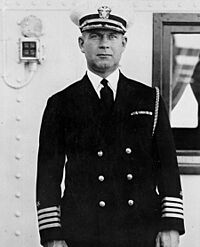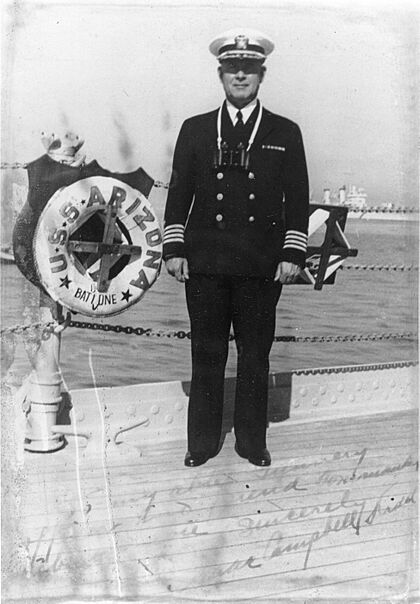Isaac C. Kidd facts for kids
Quick facts for kids
Isaac C. Kidd
|
|
|---|---|

Captain Isaac C. Kidd while he was chief of staff to the commander, Base Force, U.S. Fleet
|
|
| Born | March 26, 1884 Cleveland, Ohio |
| Died | December 7, 1941 (aged 57) Pearl Harbor, Territory of Hawaii |
| Resting place |
Hull of USS Arizona
|
| Allegiance | United States |
| Service/ |
United States Navy |
| Years of service | 1906–1941 |
| Rank | Rear Admiral |
| Commands held | USS Vega (AK-17) Port of Cristóbal, Panama Canal Zone Officer Detail Section, Bureau of Navigation Destroyer Squadron 1 USS Arizona (BB-39) Battleship Division 1 |
| Battles/wars | World War I World War II |
| Awards | Medal of Honor Purple Heart |
| Relations | Admiral Isaac C. Kidd Jr. (son) |
Isaac Campbell Kidd (March 26, 1884 – December 7, 1941) was a rear admiral in the United States Navy. He was the father of Admiral Isaac C. Kidd Jr. Kidd was killed on the bridge of USS Arizona during the Japanese attack on Pearl Harbor. The highest ranking casualty at Pearl Harbor, he became the first U.S. Navy flag officer killed in action in World War II as well as the first killed in action against any foreign enemy.
He was a posthumous recipient of his nation's highest military honor—the Medal of Honor. A Fletcher-class destroyer, Kidd (DD-661), was commissioned in his honor on April 23, 1943. The second ship named after him, Kidd (DDG-993), lead ship of four Kidd-class destroyers, was commissioned on March 27, 1981. An Arleigh Burke-class guided missile destroyer, Kidd (DDG-100), was the third ship named after him and was commissioned on June 9, 2007.
Early years and military service
Kidd was born in Cleveland, Ohio, in 1884. He entered the U.S. Naval Academy in 1902, graduating with the Class of 1906 in February of that year. He was commissioned an ensign in 1908. Kidd participated in the 1907–1909 Great White Fleet cruise around the world while serving on the battleship New Jersey. Following service on the battleship North Dakota and armored cruiser Pennsylvania, Kidd became the Aide and Flag Secretary to the Commander in Chief, Pacific Fleet, the first of his many flagstaff assignments. He was an instructor at the U.S. Naval Academy in 1916–1917.
During and after World War I, Kidd was stationed on New Mexico, and then he had further staff and Naval Academy service. He was the executive officer of the battleship Utah in 1925–1926, then commanded the Navy transport Vega until becoming the Captain of the Port at Cristóbal, Panama Canal Zone from 1927 to 1930. Promoted to the rank of captain, he was the chief of staff to the Commander, Base Force, United States Fleet in 1930–1932. After three years at the Bureau of Navigation in Washington, D.C., he was the Commander of Destroyer Squadron One, Scouting Force, in 1935–1936, stationed in Long Beach, California. The Kidd family resided in a downtown Long Beach apartment building.
During the Japanese attack on Pearl Harbor on December 7, 1941, Rear Admiral Kidd was the Commander of Battleship Division One and the Chief of Staff and Aide to the Commander, Battleship Battle Force. At his first knowledge of the attack, he rushed to the bridge of USS Arizona, his flagship, and "courageously discharged his duties as Senior Officer Present Afloat until Arizona blew up from a magazine explosion and a direct bomb hit on the bridge which resulted in the loss of his life."
Kidd's body was never recovered and to this day he is considered missing in action. U.S. Navy salvage divers located his Naval Academy ring fused to a bulkhead on Arizona's bridge. A trunk containing his personal memorabilia was found in the wreck and sent to his widow. Rediscovered in the attic by his children, both the trunk and its contents are now displayed in the museum at the USS Arizona Memorial.
Awards and decorations
Admiral Kidd posthumously received the Medal of Honor and the Purple Heart. His other awards include the Army of Cuban Pacification Medal, Mexican Service Medal, World War I Victory Medal with Atlantic Fleet Clasp, American Defense Service Medal with Fleet Clasp, Asiatic-Pacific Campaign Medal with one bronze battle star for Pearl Harbor (posthumous), and the World War II Victory Medal (posthumous).
| Medal of Honor | |||||
| Purple Heart | Cuban Pacification Medal | Mexican Service Medal | |||
| World War I Victory Medal with Atlantic Fleet Clasp |
American Defense Service Medal with Fleet Clasp |
Asiatic-Pacific Campaign Medal with star |
|||
| World War II Victory Medal | Navy Rifle Marksmanship Ribbon | Navy Pistol Marksmanship Ribbon | |||
Namesake and relations
- Three U.S. Navy destroyers have been named in Admiral Kidd's honor. See USS Kidd.
- Kidd's son, Admiral Isaac C. Kidd Jr., served in the US Navy from December 19, 1941, to 1978, eventually serving as Commander-in-Chief of the U.S. Atlantic Fleet.
- Kidd's grandson Isaac C. Kidd III retired with the rank of Navy Captain.
- Camp Kidd
- Admiral Kidd Park in West Long Beach, California, dedicated to Kidd by the Long Beach City Council on March 25, 1942
See also


